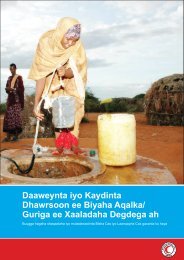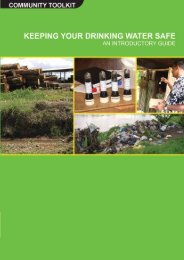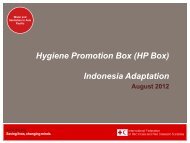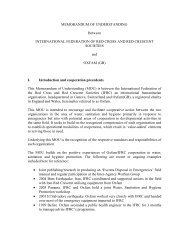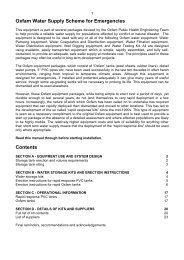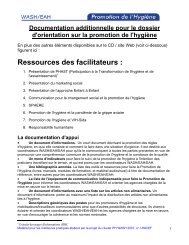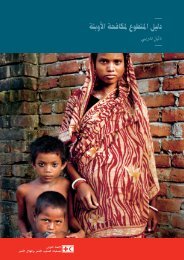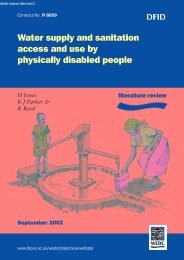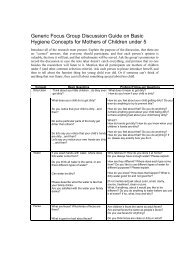process. Check TOP Contacts for contacts near you, or consult the Streams of KnowledgeCoalition (SoK) for help in tracking one down.Financial resources extend beyond the costs of salaries, training <strong>and</strong> transport. Alsoimportant is some seed money for pooling with local resources to finance smallcommunity-designed projects. In contrast, costs of educational materials are low.Community groups <strong>and</strong> workers rely on group work <strong>and</strong> home visits. Any material used forparticipatory activities (such as for PRA sessions <strong>and</strong> self-surveys) is locally available <strong>and</strong>has low or no costs. Other important items are resources for programme management <strong>and</strong>support (backstopping) to communities <strong>and</strong> for building up a programme knowledge baseto summarise the situations <strong>and</strong> achievements in individual communities over time.Financial support for hygiene promotion is sometimes difficult to get. The problem is not somuch the amount of money needed as the extended timescale <strong>and</strong> the results <strong>and</strong> impactsobtained with the funds. Demonstration of what is being achieved with the funds can helpmake hygiene promotion more attractive.Outputs: measuring behaviour changeAlthough water <strong>and</strong> sanitation professionals are generally sensitive to the need forpatience in assessing the benefits of hygiene promotion, their agency rules maysometimes dem<strong>and</strong> early results from impact analyses. However, it makes no sense to try<strong>and</strong> measure impacts. Even if reliable health statistics are available, impacts will only beginto show up after a critical mass of behaviour change has been achieved. Esrey, citedabove, showed that 75% adoption of key hygiene conditions <strong>and</strong> practices has worked assuch a critical mass for diarrhoeal diseases. Work is therefore done on monitoringtechniques that measure impacts on hygiene behaviour prior to attempts to detect impactson health. The book Actions Speak documents initial work done in this area.http://www.irc.nl/page/1836Before impacts can be assessed at all, information on outputs is needed. Outputs are anumber of operationally described improved conditions <strong>and</strong>/or practices as defined fromthe identification of risky conditions <strong>and</strong> practices. (Some also call these effects).There are a number of methods to measure effects in conditions <strong>and</strong> behaviour(behavioural change). The methods are often used in combination to test for consistency tosee whether outcomes are reliable. The most common ones are:• Structured observation of hygiene conditions <strong>and</strong> practices, e.g. observing whetherfacilities for the behaviour are in place <strong>and</strong> observing <strong>and</strong> recording behaviour e.g.during water collection, storage <strong>and</strong> drawing;• Structured observation of proxies of hygiene behaviour, e.g. the absence of excreta inyards <strong>and</strong> on rubbish heaps as an indication of the safe disposal of young children’sexcreta, or well-trodden paths <strong>and</strong> excreta in pits as indicators of latrine use;• Questioning of the ones who are most likely to know, which requires techniques todeal with interventions from others with less knowledge, who may nevertheless take30 <strong>Hygiene</strong> promotion
over for reasons of hierarchy, e.g. husb<strong>and</strong>s or mothers in law. Probing techniques areoften needed to move from polite answers to the real practices;• Using participatory tools, such as pocket voting or mapping. In pocket voting women<strong>and</strong> men in the different groups are presented with drawings that show the variousoptions <strong>and</strong> put their vote in the bag or box underneath their own, or their family’spractices. Voting is done with a token in different colours in order to allowdisaggregated analysis when all votes have been cast. The voting can be done atsome distance or behind a cloth for privacy. In social maps, neighbourhood membersindicate who have certain hygiene features, <strong>and</strong> statistics can be drawn from these,also by socio-economic group;• Microbiology, e.g. tests of stored drinking water to assess contamination duringtransport, storage <strong>and</strong> drawing;• Product measurement, e.g. sales of latrine slabs, soap consumption.When hygiene promotion campaigns are focused, short, intensive <strong>and</strong> time bound, theywill often need follow up. Very little is known about the longer-term effects of hygienepromotion. A project, financed by the European Union, to assess to what extent earlierachieved hygiene improvements are sustained has been carried out in six countries <strong>and</strong> itsresults show that single interventions are not enough.Researching behaviourResearching behaviour must be done well to get valid information <strong>and</strong> be worth theinvestment. A common error, for example, is to use the term ‘hygienic’ or ‘clean’ to denotea good practice. Such terms are open to interpretation: what is quite hygienic to observer Amay be less so to observer B. Good or bad hygiene should therefore always be definedprecisely <strong>and</strong> in such a way that everyone measures in an identical manner, e.g. smears ofexcreta in the pan/on the walls/on the floor/ on the cover. In one study that had failed to doso, the investigators found that the situation had actually worsened after the programme.This outcome came, however, not because the hygiene had deteriorated, but because theobservers themselves had become educated <strong>and</strong> so more critical: what they had scoredquite good in the pre-study they had scored as bad in the post-study! A distinction mustfurther be made between unhygienic in terms of health risks <strong>and</strong> unhygienic in terms ofaesthetics. This avoids situations where the presence of mud on the floor of the latrineduring the rainy season, or organic litter in the streets during the harvest season, may beclassified as unhygienic practices.It is further important to establish whether such behaviour is sustained over time. Findingsfrom recent research on sustained behaviour are reported athttp://www.lboro.ac.uk/well/resources/%23%23fact-sheets/fact-sheets-pdf/shb.pdfBehavioural change measurement can help to give earlier indication of cost-effectiveness,but there remains a need to educate non-sector personnel in donor agencies <strong>and</strong> nationalgovernments about the timescale needed for health benefits to be demonstrated. Casestudies such as the one in Dosso, Niger (see chapter 6), are helping to show that hygienepromotion is cost-effective. As most of the materials used for community-based work are<strong>IRC</strong> <strong>International</strong> <strong>Water</strong> <strong>and</strong> <strong>Sanitation</strong> <strong>Centre</strong> 31
- Page 2: Please note that the TOPs are a web
- Page 7 and 8: 1. Hygiene PromotionWhat do you kno
- Page 9 and 10: 2. Why hygiene promotion matters2.1
- Page 11 and 12: • The costs of inaction can be hi
- Page 13 and 14: 3. Learning from experiences and re
- Page 15 and 16: • Hygiene Improvement Framework (
- Page 17 and 18: groups, and facilitators of partici
- Page 19 and 20: The diagrams are taken from McKee
- Page 21 and 22: • Food, utensils and food prepara
- Page 23 and 24: Guides for developing hygiene promo
- Page 25 and 26: • What may prevent this change in
- Page 27 and 28: areas, slabs and sanplats for latri
- Page 29 and 30: often not taken seriously and their
- Page 31: IIIIIIIVVInputsProcOutpEffectiImpae
- Page 35 and 36: 5. Case studiesOn the following pag
- Page 37 and 38: The Project recognises the importan
- Page 39 and 40: almost all cases been exceeded, as
- Page 41 and 42: skin diseases, HIV/AIDS and tubercu
- Page 43 and 44: understanding of the importance of
- Page 45 and 46: councils (JSCs) are associations of
- Page 47 and 48: o through a schools programme, with
- Page 49 and 50: outputs and outcomes are focused mo
- Page 51 and 52: Harvey, Eric, Shadrack Dau, Alana P
- Page 53 and 54: programmes more effective. The obje
- Page 55 and 56: scale. Comparison is on approach, l
- Page 57 and 58: Hygiene Behaviour Network, in Globa
- Page 59 and 60: WHO - World Health Organizationhttp
- Page 61 and 62: Tel: (703) 247-8730Fax: (703) 243-9
- Page 63 and 64: Manila, PhilippinesTel: +632 911-57
- Page 65 and 66: TOP Courses and conferencesCREPA, B
- Page 67 and 68: TOP ReferencesBoot, Marieke T. and
- Page 69 and 70: TOP Quiz on Hygiene PromotionTry it
- Page 71 and 72: Question 4All the interventions wil
- Page 73 and 74: Then you may decide that this paper
- Page 75 and 76: Appendix 1. Hygiene promotion manua
- Page 77 and 78: 2. Target specific audiences.These
- Page 79 and 80: Appendix 4. WASH facts and figures1
- Page 81 and 82: Research)18: (IHE Newsletter, Janua
- Page 83 and 84:
Appendix 6. Preventive measuresMeas
- Page 85 and 86:
Appendix 8. Some key objectives for
- Page 87 and 88:
Appendix 9. Participatory tools and
- Page 89 and 90:
Appendix 10. The PHAST approachFor
- Page 91 and 92:
Planning techniques are used to sim
- Page 93 and 94:
While sensitive topics are often be
- Page 95:
About IRCIRC facilitates the sharin



